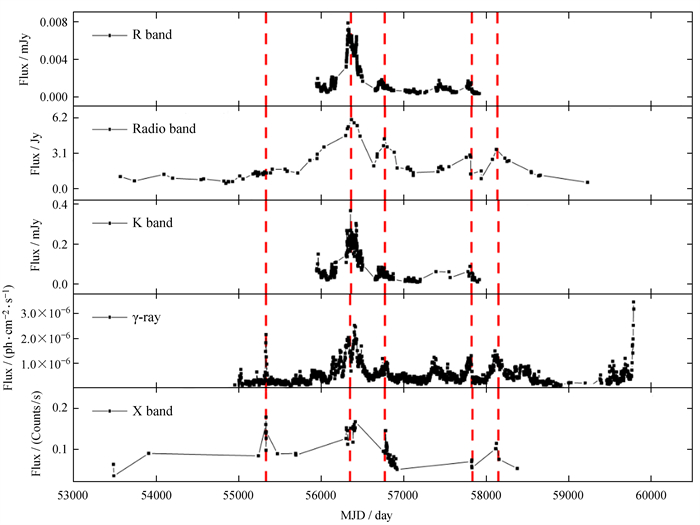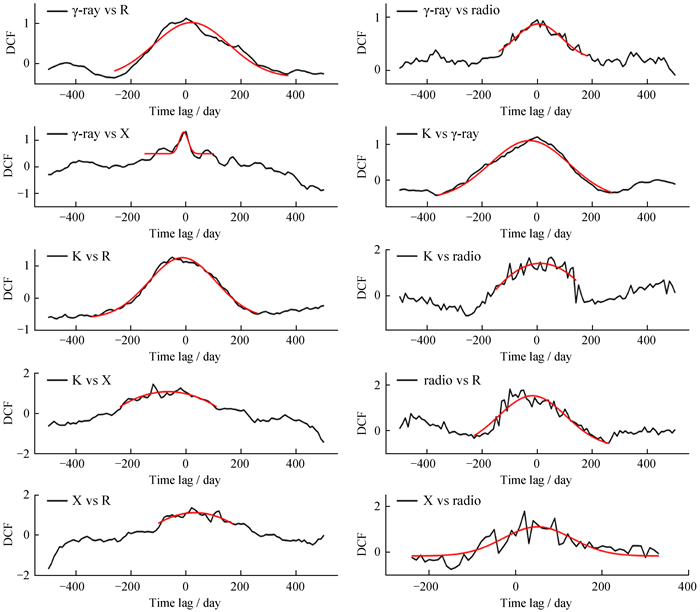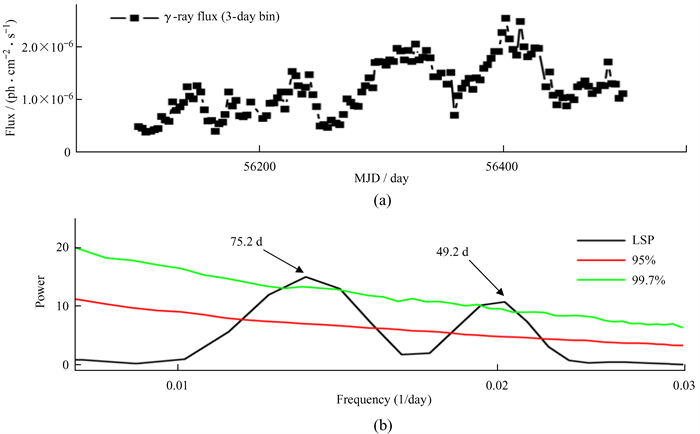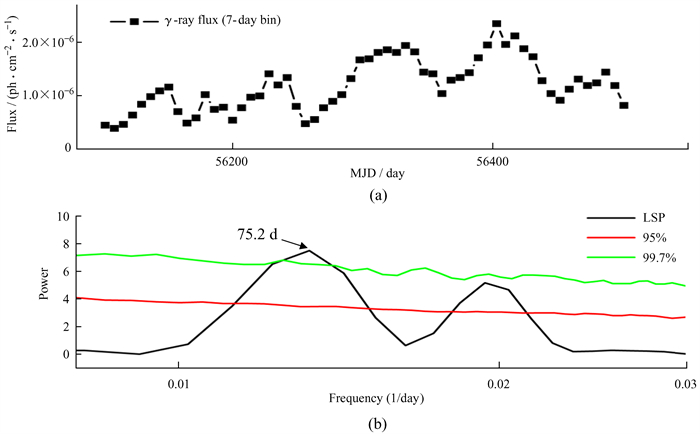2. 广西相对论天体物理重点实验室, 广西 南宁 530004
2. Guangxi Key Laboratory for the Relativistic Astrophysics, Nanning 530004, China
耀变体是活动星系核(Active Galactic Nuclei, AGN)中的一类,其相对性喷流几乎正对地球(角度≤10°)[1];它具有光度高、光变快、偏振高的特点,且具有从射电波段到γ波段的非热辐射。根据光学或红外光谱中的发射线,耀变体又可以分为平谱射电类星体(Flat-Spectrum Radio Quasar, FSRQ)和蝎虎座BL型天体(BL Lac)[2]。其中蝎虎座BL型天体只存在一些微弱的发射线,甚至没有发射线,却辐射出很强的X射线和γ射线。对于耀变体高能γ射线的产生机制,学者提出了不同的辐射模型进行解释,比如同步自康普顿(Synchrotron Self-Compton, SSC)模型和外康普顿机制(External Compton, EC)[3]。目前大家普遍认为γ射线来自于喷流。
PKS 1424-41是一个红移为1.522的平谱射电类星体[4-7],同步峰的峰值频率的对数为13.517 Hz。文[8]发现该源在γ波段存在年量级的准周期振荡,振荡周期约为355天。文[9]对PKS 1424-41在时间段MJD56000-56600做了多波段分析,发现红外波段与γ波段可能来自于同一区域。文[10]利用离散相关函数计算得到PKS 1424-41在γ波段和射电波段(2.3 GHz,4.8 GHz,12.2 GHz和8.4 GHz)相关性较好,且γ波段超前于射电波段。那么γ波段和光学波段,光学波段和射电波段是否存在相关性?同时,除了文[8]得到的准周期振荡以外,该耀变体是否还存在其他的准周期振荡?为此,我们收集最新Fermi(LAT)提供的γ波段数据、SMA发布的射电波段数据以及智利的美洲天文台SMARTS发布的光学数据,进行相关性研究和周期分析,以探讨上述问题。
1 数据样本和光变曲线本文收集到来自Fermi γ射线空间卫星[11-13]在γ射线(4FGL J1427.9-4206)数据点836个;SWIFT(XRT)的X波段数据点78个;SMA的射电波段数据点86个;SMARTS中光学R波段数据点564个[14],近红外K波段数据点438个。其中,光学波段中的观测数据是星等值,我们利用
| $ F_{\mathrm{v}}=3640 \times 10^{\frac{m_{\mathrm{v}}}{-2.5}} $ | (1) |
将星等值转化为流量数据,其中,mv是光学波段的星等值;Fv是星等值对应的流量。各波段光变曲线如图 1。

|
| 图 1 PKS 1424-41在光学γ波段、X波段、光学R波段、近红外K波段和射电波段的光变曲线 Fig. 1 The light curves of PKS 1424-41 in gamma-ray, X-ray, optical R, near-infrared K and radio band |
分析两组离散数据的相关性方法较多,比如离散相关函数。离散相关函数在天体物理中的应用较多[15-19],该方法的优点在于可以分析间隔不均匀的数据,而且不需要对数据样本做任何插值处理,这与天文观测数据很好地契合。
设有任意两个离散数据序列Ai和Bj,则两组数的离散相关函数为
| $ U D C F_{i j}=\frac{\left(A_i-\bar{A}\right)\left(B_j-\bar{B}\right)}{\sigma_{\mathrm{A}} \sigma_{\mathrm{B}}}, $ | (2) |
其中,A和B分别为离散数据序列Ai和Bj的平均值;σA和σB分别为相应的标准偏差。每一个数值的UDCFij值与时间延迟
通过离散相关函数对PKS 1424-41的γ波段分别与射电波段、X波段、近红外K波段和光学R波段做相关性分析,我们得到:(1)γ波段与各个波段均存在极强的相关性(峰值相关系数DCFpeak>0.8);在时间上,γ波段超前其他各波段,分别为0天(X波段)、28.4天(K波段)、19.6天(R波段)和3.5天(射电波段);(2)X波段与光学R波段、近红外K波段和射电波段间均存在强相关性(DCFpeak>0.8);(3)光学R波段与近红外K波段和射电波段有极强的相关性。各波段间的相关性分析图像如图 2,各波段间的相关性曲线峰值的高斯拟合结果如表 1。

|
| 图 2 PKS 1424-41各波段间的离散相关函数分析,以及离散相关函数峰值附近的高斯拟合 Fig. 2 The DCFs of the light curves of PKS 1424-41 bands and the Gaussian fitting of the peak segments |
| Gaussian fitting parameters | X vs R | radio vs R | K vs X | K vs radio | K vs R | K vs γ | γ vs X | γ vs radio | X vs radio | γ vs R |
| μ | 35.4 | -18.6 | -65.0 | 11.4 | -13.4 | -28.4 | 0 | 3.5 | 50.4 | 19.6 |
| DCFpeak | 1.37 | 1.77 | 1.28 | 1.67 | 1.28 | 1.22 | 1.32 | 0.95 | 1.27 | 1.13 |
LSP方法可以减少由于时间序列不均匀带来的虚假信号,还可以在红噪声中找出虚弱的光变周期[20]。因此,LSP方法广泛应用于寻找光变周期[21-23]。该方法是基于傅里叶变换,将输入的信号特征从时域转为频域。基本公式为[24]
| $ P(\omega)=\frac{1}{2}\left\{\frac{\left[\sum\limits_{i=1}^{N_0} x\left(t_i\right) \cos \omega\left(t_i-\tau\right)\right]^2}{\sum\limits_{i=1}^{N_0} \cos ^2 \omega\left(t_j-\tau\right)}+\frac{\left[\sum\limits_{i=1}^{N_0} x\left(t_i\right) \sin \omega\left(t_i-\tau\right)\right]^2}{\sum\limits_{i=1}^{N_0} \sin ^2 \omega\left(t_i-\tau\right)}\right\}, $ | (3) |
其中,τ为对应时间t的相位修正,计算公式为
| $ \tan (2 \omega \tau)=\frac{\sum\limits_{i=1}^{N_0} \sin \left(2 \omega t_i\right)}{\sum\limits_{i=1}^{N_0} \cos \left(2 \omega t_i\right)} . $ | (4) |
文[8]对该源在γ波段的部分数据做周期性分析,得到355天左右的暂现准周期振荡。我们对这个源在时间段MJD 56100-56500做周期分析,结果表明,该源在γ波段具有月量级的准周期振荡。在以3天为时间间隔(time bin)的γ波段光变曲线(图 3)中,有两个准周期振荡,分别为75.2天(>3σ)和49.2天(>3σ);在以7天为时间间隔(图 4)时,也有两个准周期振荡,分别为75.2天(>3σ)和51天(< 3σ)。该源在光学波段、射电波段和X波段未发现周期,这可能由于射电波段和X波段数据点稀少,光学波段因为天气、季节等因素导致观测数据空缺。

|
| 图 3 PKS 1424-41在γ波段(时间间隔3天)的光变曲线(MJD 56100-56500)和LSP计算结果。(a)光变曲线;(b)LSP计算结果 Fig. 3 The gamma-ray light curve of PKS 1424-41 with 3-day bin (MJD 56100-56500) and LSP calculation results. (a) The light curve; (b) the LSP calculation results |

|
| 图 4 PKS 1424-41在γ波段(时间间隔7天)的光变曲线(MJD 56100-56500)和LSP计算结果。(a)光变曲线;(b)LSP计算结果 Fig. 4 The gamma-ray light curve of PKS 1424-41 with 7-day bin (MJD 56100-56500) and LSP calculation results. (a) The light curve; (b) the LSP calculation results |
基于PKS 1424-41在γ波段、X波段、光学R波段、近红外K波段和射电波段的观测数据,我们用离散相关函数对各个波段间做了相关性分析。结果显示,X波段与光学R波段、近红外K波段与射电波段间均存在强相关性;且X波段在时间上超前于各波段,超前时间分别为35.4天、65天和50.4天;光学R波段与近红外K波段和射电波段有极强的相关性。但γ波段与X波段存在极强的相关性,不存在时间延迟。研究结果表明,γ射线活动(可变性)在十几天内略早于光学R波段,不同波段的辐射源于同一区域(同一电子群)。这个结果支持单区轻子辐射模型[25-27]。但是,由于X波段和射电波段的数据点较少,这一结果还需要进一步的观测验证。
用LSP方法对γ波段在时间段MJD 56100-56500内的光变曲线进行周期分析,在时间间隔为3天的光变曲线中,存在两个准周期振荡,分别是75.2天和49.2天,置信度均大于3σ,这两个准周期振荡的比值约为3∶2。在时间间隔为7天的光变曲线中,存在一个75.2天的准周期振荡(置信度大于3σ),同时还存在一个51天的准周期振荡(置信度超过2σ不足3σ),两个准周期振荡的比值也接近3∶2。目前,耀变体准周期光变的物理本质还无法确定,但是耀变体光变曲线中的准周期振荡背后的物理机制已广泛讨论,并提出了许多可能的物理模型。具体的物理模型有:(1)超大质量双黑洞(Supermassive Binary Black Hole, SMBBH)系统,次级黑洞可以通过在轨道运动过程中穿过主黑洞的吸积盘,从而诱导准周期性[28-30]。(2)带有厚盘的超大质量双黑洞系统激发厚盘的p模振荡,随后振荡吸积盘的准周期等离子体注入喷流,因此喷流发射产生准周期流[31-32];如果内盘的角动量与中心超大质量黑洞的自旋不平行,它将围绕中心黑洞的自旋做Lense-Thirring进动[33-34]。相关喷流的方向也有进动[35-37],因此在每个电磁波段产生流量变化。(3)如果喷流具有大尺度螺旋状磁场,或者由于流体动力学不稳定、相对论冲击波或喷流等离子体中的湍流[38-39],喷流本身呈螺旋状,喷流辐射流量的变化也是准周期性的[40]。我们的分析结果更趋向于支持第3种模型。耀变体的准周期光变的物理本质仍然需要做进一步的研究。
| [1] | ANTONUCCI R. Unified models for active galactic nuclei and quasars[J]. Annual Review of Astronomy and Astrophysics, 1993, 31(1): 473–521. DOI: 10.1146/annurev.aa.31.090193.002353 |
| [2] | PADOVANI P. Unified schemes for radio-loud AGN: recent results[J]. Memorie della Societa Astronomica Italiana, 1997, 68: 47–54. |
| [3] | ZHANG X, YANG W G, HOU D D, et al. The variations characteristics and black hole mass of H0323+022 objects research[J]. Acta Physica Sinica, 2005, 54(6): 2961–2968. DOI: 10.7498/aps.54.2961 |
| [4] | HASAN I, MACPHERSON E, BUXTON M, et al. Latest OIR mags of PKS 1424-41[EB/OL]. (2013-01-31)[2023-03-29]. https://www.astronomerstelegram.org/? read=4775. |
| [5] | D'AMMANDO F, ORIENTI M, LONGO F, et al. Detection of a strong optical and gamma-ray flare from blazar PKS 1424-41[EB/OL]. (2013-01-08)[2023-03-29]. https://www.astronomerstelegram.org/? read=4714. |
| [6] | SAFNA P Z, STALIN C S, RAKSHIT S, et al. Long-term optical and infrared variability characteristics of Fermi blazars[J]. Monthly Notices of the Royal Astronomical Society, 2020, 498(3): 3578–3591. DOI: 10.1093/mnras/staa2622 |
| [7] | WHITE G L, JAUNCEY D L, SAVAGE A, et al. Redshifts of southern radio sources. Ⅶ[J]. The Astrophysical Journal, 1988, 327: 561–569. DOI: 10.1086/166216 |
| [8] | YANG J P, CAO G, ZHOU B, et al. Quasi-periodic oscillation of blazar PKS 1424-418 in γ-ray band[J]. Publications of the Astronomical Society of the Pacific, 2021, 133(1020): 024101. DOI: 10.1088/1538-3873/abd152 |
| [9] | ABHIR J, JOSEPH J, PATEL S R, et al. Multi-frequency temporal and spectral variability study of blazar PKS 1424-418[J]. Monthly Notices of the Royal Astronomical Society, 2021, 501(2): 2504–2511. DOI: 10.1093/mnras/staa3639 |
| [10] | VAN ZYL P V, GAYLARD M J. Examining the radio to gamma-ray correlation of the blazar PKS 1424-418 during its flaring state[J]. Memorie della Societa Astronomica Italiana, 2015, 86: 36–41. |
| [11] | SZOSTEK A. Fermi LAT detection of a new GeV flare from blazar PKS 1424-4[EB/OL]. (2011-05-08)[2023-03-29]. https://www.astronomerstelegram.org/? read=3329. |
| [12] | DONATO D. Fermi LAT detection of a GeV flare from blazar PKS 1424-41[EB/OL]. (2010-04-23)[2023-03-29]. https://www.astronomerstelegram.org/? read=2583. |
| [13] | KADLER M, STEVENS J, OJHA R, et al. ATCA finds a long-term radio outburst of PKS1424-418 coincident with optical/gamma-ray flaring activity[EB/OL]. (2022-08-02)[2023-03-29]. https://www.astronomerstelegram.org/? read=15536. |
| [14] | BONNING E, BAILYN C, BUXTON M, et al. SMARTS optical and IR observations of PKS 1424-41[EB/OL]. (2011-05-10)[2023-03-29]. https://www.astronomerstelegram.org/? read=3337. |
| [15] |
程勇, 张雄, 伍林, 等. 用离散相关函数方法分析Blazar天体的γ射线和射电辐射的相关性[J]. 物理学报, 2006, 55(2): 988–994 CHENG Y, ZHANG X, WU L, et al. Analysis of the correlation between γ-ray and radio emissions from γ-ray loud Blazar using the discrete correlation function[J]. Acta Physica Sinica, 2006, 55(2): 988–994. |
| [16] |
刘文广, 李冬冬, 熊定荣, 等. 费米耀变体源多波段辐射流量的相关性分析[J]. 云南师范大学学报(自然科学版), 2012, 32(5): 1–6 LIU W G, LI D D, XIONG D R, et al. The correlation analysis of multi-wavelength emission from Fermi blazars[J]. Journal of Yunnan Normal University (Natural Sciences Edition), 2012, 32(5): 1–6. |
| [17] |
王兴华, 张雄. 离散相关函数在Blazar天体中的应用[J]. 云南师范大学学报(自然科学版), 2010, 30(6): 25–33 WANG X H, ZHANG X. Applying the discrete correlation function to Blazar object[J]. Journal of Yunnan Normal University (Natural Sciences Edition), 2010, 30(6): 25–33. |
| [18] | ZHOU B, DAI B, YANG J P. Long-term multiband correlation study and spectral energy distribution modeling of blazar 3C 454.3[J]. Publications of the Astronomical Society of Japan, 2021, 73(4): 850–863. DOI: 10.1093/pasj/psab051 |
| [19] | EDELSON R A, KROLIK J H. The discrete correlation function: a new method for analyzing unevenly sampled variability data[J]. The Astrophysical Journal, 1988, 333: 646–659. DOI: 10.1086/166773 |
| [20] | CHEN J P, YI T F, GONG Y L, et al. A 31.3 day transient quasiperiodic oscillation in gamma-ray emission from blazar S5 0716+714[J]. The Astrophysical Journal, 2022, 938(1): 8–17. DOI: 10.3847/1538-4357/ac91c3 |
| [21] |
常鑫, 易庭丰, 杨星, 等. BL Lac天体CGRaBS J0141-0928的光变特性分析[J]. 天文研究与技术, 2022, 19(5): 401–411 CHANG X, YI T F, YANG X, et al. Analysis of optical property of BL Lac object CGRaBS J0141-0928[J]. Astronomical Research & Technology, 2022, 19(5): 401–411. |
| [22] |
陈军平, 马力, 龚云露, 等. 耀变体CGRaBS J0929+5013和J2146-1525光变相关性及准周期分析[J]. 天文研究与技术, 2022, 19(3): 189–197 CHEN J P, MA L, GONG Y L, et al. Correlation and quasi-periodic oscillation analysis of light variation in blazar CGRaBS J0929+5013 and J2146-1525[J]. Astronomical Research & Technology, 2022, 19(3): 189–197. |
| [23] |
杨星, 易庭丰, 毛李胜. 平谱射电类星体B30307+380的15 GHz射电光变分析[J]. 天文研究与技术, 2020, 17(2): 137–143 YANG X, YI T F, MAO L S. On the 15 GHz radio variability of flat-spectrum radio quasar B30307+380[J]. Astronomical Research & Technology, 2020, 17(2): 137–143. |
| [24] | YANG X, YI T F, ZHANG Y, et al. The γ-ray and optical variability analysis of the BL Lac object 3FGL J0449.4 4350[J]. Publications of the Astronomical Society of the Pacific, 2020, 132(1010): 044101. DOI: 10.1088/1538-3873/ab779e |
| [25] | CARNERERO M I, RAITERI C M, VILLATA M, et al. Multiwavelength behaviour of the blazar OJ 248 from radio to γ-rays[J]. Monthly Notices of the Royal Astronomical Society, 2015, 450(3): 2677–2691. DOI: 10.1093/mnras/stv823 |
| [26] | SOKOLOV A, MARSCHER A P, MCHARDY I M. Synchrotron self-Compton model for rapid nonthermal flares in blazars with frequency-dependent time lags[J]. The Astrophysical Journal, 2004, 613(2): 725–746. DOI: 10.1086/423165 |
| [27] | SIKORA M, BŁAZŻEJOWSKI M, BEGELMAN M C, et al. Modeling the production of flares in gamma-ray quasars[J]. The Astrophysical Journal, 2001, 554(1): 1–11. DOI: 10.1086/321329 |
| [28] | SANDRINELLI A, COVINO S, DOTTI M, et al. Quasi-periodicities at year-like timescales in blazars[J]. The Astronomical Journal, 2016, 151(3): 54. DOI: 10.3847/0004-6256/151/3/54 |
| [29] | VILLFORTH C, NILSSON K, HEIDT J, et al. Variability and stability in blazar jets on time-scales of years: optical polarization monitoring of OJ 287 in 2005-2009[J]. Monthly Notices of the Royal Astronomical Society, 2010, 402(3): 2087–2111. DOI: 10.1111/j.1365-2966.2009.16133.x |
| [30] | VALTONEN M J, LEHTO H J, NILSSON K, et al. A massive binary black-hole system in OJ287 and a test of general relativity[J]. Nature, 2008, 452(7189): 851–853. DOI: 10.1038/nature06896 |
| [31] | ACKERMANN M, AJELLO M, ALBERT A, et al. Multiwavelength evidence for quasi-periodic modulation in the gamma-ray blazar PG 1553+113[J]. The Astrophysical Journal, 2015, 813(2): L41. DOI: 10.1088/2041-8205/813/2/L41 |
| [32] | LIU F K, CHEN X. Evolution of supermassive black hole binaries and acceleration of jet precession in galactic nuclei[J]. The Astrophysical Journal, 2007, 671(2): 1272–1283. DOI: 10.1086/522910 |
| [33] | LI H Z, XIE G Z, ZHOU S B, et al. A periodicity analysis of the light curve of 3C 454.3[J]. Chinese Journal of Astronomy and Astrophysics, 2006, 6(4): 421–429. DOI: 10.1088/1009-9271/6/4/04 |
| [34] | WILKINS D C. Bound geodesics in the kerr metric[J]. Physical Review D, 1972, 5(4): 814. DOI: 10.1103/PhysRevD.5.814 |
| [35] | CAPRONI A, MOSQUERA CUESTA H J, ABRAHAM Z. Observational evidence of spin-induced precession in active galactic nuclei[J]. The Astrophysical Journal, 2004, 616(2): L99–L102. DOI: 10.1086/426863 |
| [36] | CAPRONI A, ABRAHAM Z. Can long-term periodic variability and jet helicity in 3C 120 be explained by jet precession?[J]. Monthly Notices of the Royal Astronomical Society, 2004, 349(4): 1218–1226. DOI: 10.1111/j.1365-2966.2004.07550.x |
| [37] | KUDRYAVTSEVA N A, BRITZEN S, WITZEL A, et al. A possible jet precession in the periodic quasar B0605-085[J]. Astronomy & Astrophysics, 2011, 526: A51. |
| [38] | MARSCHER A P, GEAR W K. Models for high-frequency radio outbursts in extragalactic sources, with application to the early 1983 millimeter-to-infrared flare of 3C 273[J]. The Astrophysical Journal, 1985, 298: 114–127. DOI: 10.1086/163592 |
| [39] | LARIONOV V M, JORSTAD S G, MARSCHER A P, et al. The outburst of the blazar S5 0716+71 in 2011 October: shock in a helical jet[J]. The Astrophysical Journal, 2013, 768(1): 40. DOI: 10.1088/0004-637X/768/1/40 |
| [40] | CAMENZIND M, KROCKENBERGER M. The lighthouse effect of relativistic jets in blazars. A geometric origin of intraday variability[J]. Astronomy & Astrophysics, 1992, 255: 59–62. |



